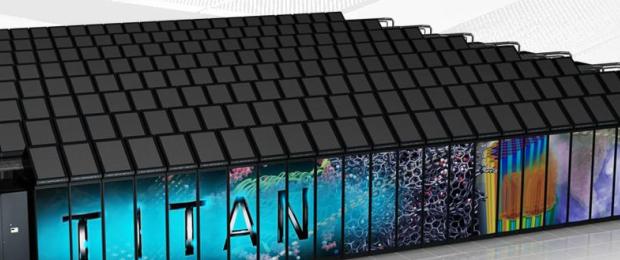The first place in the ranking of the 500 most powerful supercomputers in the world has recently been taken by Titan, a colossal machine commissioned in late 2012. It has surpassed fellow giant Sequoia in the measurements made by the ‘Top 500’ project to assess which IT systems have the greatest capacity.
Built by supercomputer manufacturer Cray, Titan has a system with 18,688 nodes, each of which is composed of an AMD Opteron 6274 16-core processor (CPU) and GPU (graphic processor unit) NVIDIA Tesla K20. The efficiency of these calculation accelerators has been optimized to the maximum. The combination of these two elements, CPU and GPU, is new to machines at this scale; it reduces their size and also lowers energy consumption. It has a total memory of over 700 TB.
The measurements taken by the ‘Top500’ project recorded a display of 17.59 petaflops, that is, 17,590 trillion calculations per second. The creators claim that the capacity of the machine can reach 27 petaflops (equivalent to 1,000 trillion calculations per second).
The third most powerful supercomputer in the ranking works at 10.51 petaflops, while the tenth reaches 1.51 petaflops. Coming back down to earth, the performance of current computers is in the range of hundreds of gigaflops. A petaflop is the same as a million gigaflops.
Energy efficiency despite everything
Titan was commissioned by Oak Ridge National Laboratory in the United States, under the country’s Department of Energy. This organization is dedicated to advanced scientific research, ranging from the climate or the environment to national security.
Today, one of the challenges in the field of supercomputers is energy efficiency and this was taken into account when Titan was designed. «Combining GPU and CPU in a single system requires less energy and is a responsible move to reduce environmental impact,» said Jeff Nichols, associate director of Oak Ridge National Laboratory for information technology and computer science.
At a maximum performance of 27 petaflops, Titan consumes 9 megawatts of electricity. To give an idea of the enormity of this, it would take 9,000 households to consume the same amount of energy. Titan’s predecessor at the Oak Ridge National Laboratory, Jaguar XT5, consumed 20% less energy, but was 10 times less powerful. Using GPUs has enabled a significant increase in calculation power while observing efficiency and preventing consumption from soaring.
Scientific Uses
Its colossal size occupies an area of 400 square metres. In this space the machine occupies 200 cabinets full of hardware and wiring to connect the 560,640 cores it has between CPU and GPU processors. The purpose of it all is to aid scientific research.
The projects being carried out include the discovery of the magnetic properties of materials. Technological breakthroughs may depend on these properties in the near future, so the research is of great interest. Nuclear power is another area on which Titan focuses its attention. Simulating a cycle of use in a nuclear reactor takes 13 hours, while previously, with Jaguar XT5, it took 60 hours.
Titan is also designed to perform in-depth calculations in the atmospheric field. It will study climate change through long-term simulations, which will help scientists understand what air quality will be like in the future and what effect suspended particles will have on the environment.
The supercomputer also address everyday energy issues. One of the projects is intended to optimize the current model of the combustion engine in order to save oil, an increasingly precious energy source.









